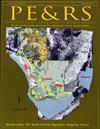基于增强样本的实时时空光谱解混
IF 2
4区 地球科学
Q4 GEOGRAPHY, PHYSICAL
引用次数: 0
摘要
近年来,为了充分挖掘MODIS -Landsat影像对等多尺度时间信息,对MODIS数据等粗时间序列进行光谱解混,发展了时空光谱解混方法(STSU)。为了进一步增强实时监测的应用,针对实时数据,开发了实时STSU(RSTSU)方法。在RSTSU中,我们通常选择空间完整的MODIS-Landsat图像对作为辅助数据。由于云污染,所需有效辅助数据与待待混合实时数据之间的时间距离可能较大,导致提取的未变化像元(即训练样本)的土地覆盖变化较大,不确定性较大。在本文中,为了提取更可靠的训练样本,我们建议选择时间上最接近预测时间的辅助MODIS-Landsat数据。为了处理辅助数据中的云污染,我们提出了一种基于增强样本的RSTSU(ARSTSU)方法。ARSTSU对有效(即非云)区域中提取的训练样本进行选择和增强,合成更多的训练样本,然后训练出一个有效的学习模型来预测比例。ARSTSU在实验中使用两个MODIS数据集进行验证。ARSTSU通过解决实际情况中时间邻居的云污染问题,扩展了RSTSU的适用性。本文章由计算机程序翻译,如有差异,请以英文原文为准。
Augmented Sample-Based Real-Time Spatiotemporal Spectral Unmixing
Recently, the method of spatiotemporal spectral unmixing (STSU ) was developed to fully explore multi-scale temporal information (e.g., MODIS –Landsat image pairs) for spectral unmixing of coarse time series (e.g., MODIS data). To further enhance the application for timely monitoring,
the real-time STSU( RSTSU) method was developed for real-time data. In RSTSU, we usually choose a spatially complete MODIS–Landsat image pair as auxiliary data. Due to cloud contamination, the temporal distance between the required effective auxiliary data and the real-time data to be
unmixed can be large, causing great land cover changes and uncertainty in the extracted unchanged pixels (i.e., training samples). In this article, to extract more reliable training samples, we propose choosing the auxiliary MODIS–Landsat data temporally closest to the prediction time.
To deal with the cloud contamination in the auxiliary data, we propose an augmented sample-based RSTSU( ARSTSU) method. ARSTSU selects and augments the training samples extracted from the valid (i.e., non-cloud) area to synthesize more training samples, and then trains an effective learning
model to predict the proportions. ARSTSU was validated using two MODIS data sets in the experiments. ARSTSU expands the applicability of RSTSU by solving the problem of cloud contamination in temporal neighbors in actual situations.
求助全文
通过发布文献求助,成功后即可免费获取论文全文。
去求助
来源期刊

Photogrammetric Engineering and Remote Sensing
地学-成像科学与照相技术
CiteScore
1.70
自引率
15.40%
发文量
89
审稿时长
9 months
期刊介绍:
Photogrammetric Engineering & Remote Sensing commonly referred to as PE&RS, is the official journal of imaging and geospatial information science and technology. Included in the journal on a regular basis are highlight articles such as the popular columns “Grids & Datums” and “Mapping Matters” and peer reviewed technical papers.
We publish thousands of documents, reports, codes, and informational articles in and about the industries relating to Geospatial Sciences, Remote Sensing, Photogrammetry and other imaging sciences.
 求助内容:
求助内容: 应助结果提醒方式:
应助结果提醒方式:


